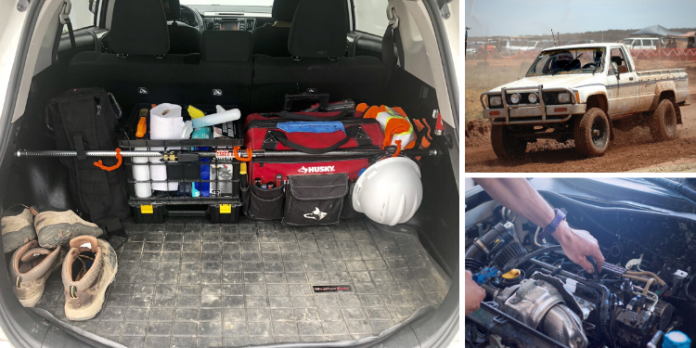The issue with emergencies and disasters is that we can’t schedule our lives around them because they don’t happen on a regular schedule.
An SHTF situation can happen at any time, and there is a good chance that you won’t be at home, that you’ll need to leave your house to get family members, or that you’ll need to bug out.
Our cars and trucks will always be our main mode of transportation, but if you haven’t prepared them for SHTF, you might discover that they end up being more trouble than they’re worth.
Fortunately, getting your car ready for SHTF is simple and will help you survive a disaster.
1. Create Good Habits
Creating habits that will help us in navigating a post-SHTF environment is a crucial component of preparedness.
For instance, one of the driving habits we all need to develop is to never let our gas tanks go too low.
2. How to Get Your Car Ready for SHTF
Always top off the tank when you find it is between three-quarters and half full to do this.
You should never, under any circumstances, have less than half a tank of fuel. Additionally, you should monitor your mileage and be aware of how far a tank of gas will take you.
Secondly, developing a situational awareness habit is crucial. Pay attention to the areas you pass through every day as you drive, and attempt to envision the problems you might encounter if you had to pass through them after SHTF.
For instance, if you travel through areas with a history of violence, you might assume that they will be particularly dangerous after SHTF.
Plan and practice alternate routes to and from work, school, your friends and family’s houses, and any other locations you might need to visit after SHTF.
Making a point of inspecting your car once a week is a great habit to develop. Check all the possible things, including fluids, lights, tire pressure, suspension, batteries, hoses, and suspension. By doing this, issues can be found before they cost money.
3. Maintenance
Keep regular maintenance.
We are all guilty of ignoring the noises that typically sound pricey, like clicks, clunks, and squeaks. You should base the maintenance of your car on the recommended routine maintenance items and intervals listed by all vehicle manufacturers.
Check the fluid levels regularly, look at the steering and suspension from underneath the car, check the hoses in the cooling system, check and replace the air filters, and make sure your tires are in good shape.
You must be aware of these issues so you can address them before SHTF because every make and model of vehicle has known problems.
It’s also crucial to learn how to perform regular maintenance on your vehicle. You should be able to recognize typical problems as well as change a tire, change the oil, fix coolant leaks, use jumper cables safely, replace air filters, and change light bulbs.
4. Upgrades
No matter what kind of car you drive, there are a few items that should be upgraded to make it more useful in an emergency or disaster.
If you reside in an area where there is a lot of snowfall, invest in a pair of snow-specific tires or update to all-weather tires and keep a set of chains on hand.
If you own a truck or SUV, installing bush bars, skid plates, and roof racks is useful.
If you are an authorized amateur radio operator, your car should be equipped with a VHF/UHF radio.
You should get a full-sized spare tire if your car lacks one. The spare tires that come standard on most cars are made to allow the car to travel a short distance at a slower speed while you fix the flat tire. Unfortunately, there won’t be any tire shops open after SHTF.
6. Getting the Car Ready
A bug-out bag and a car emergency kit should be included in every vehicle. The major problems you can encounter on a daily basis should be included in a vehicle emergency kit. These items are also valuable in an SHTF scenario as well.
Several noteworthy items to mention are:
- Jumper cables
- High-vis vest
- Road flares
- Flashlight
- Wheel chocks
- Basic tool kit
- Gloves
- Disposable coveralls
- Rain poncho
- Reflective hazard signs
- Distilled water or premixed coolant
- Tire repair kit
- JB weld
- Bailing wire
- Hose repair kit
- Fire Extinguisher
- Zip-ties
- Shovel
- Tire chains
This is a basic list of supplies to include in your car’s emergency kit. Include anything else you might require in case of a roadside emergency or an SHTF scenario.
Everything you’ll need to return home from work, school, or wherever else you may be when SHTF happens should already be in your bug-out bag.
The bag’s contents are mostly determined by the distance and challenges you would have to overcome to get home.
The tiny size and light weight of these mini bugout bags allow you to move swiftly through urban areas while still providing all the essentials for survival.
7. Prepare Yourself For Emergencies
A car or truck can end up being a cage that holds us inside after a collision or if it ends up in a river or lake. In these situations, the only option to save oneself from certain death may be to shatter a window and cut ourselves free of seat belts.
Therefore, it would be best to have a seat belt cutter/glass breaker on hand so that you can cut yourself free from the belt and break the window. There is no reason not to keep one of these tools in each vehicle you own given their low cost.
Make sure it is easily accessible and secure enough to prevent it from flying away in the case of a rollover wherever you decide to store it.
Accidents and injuries do occur, so while you are away from home, you must be prepared with a first-aid kit to handle any wounds or injuries you may experience. As a result, separate from your bugout bag or get-home pack, create a first-aid kit specifically for each vehicle.
Learn about the capabilities of your vehicles and join a reliable defensive driving course.
No matter how well-built your automobile is or how well you’ve prepared it for SHTF, if you damage it in the first few minutes of an emergency, all of your planning will be useless.
The majority of people in North America rely on their cars for everyday transportation, so we must take precautions to protect them in case of SHTF.
By keeping up on maintenance, making sure the tank is full, and keeping an emergency kit and get-home bag in the trunk, we can become better prepared for SHTF.



